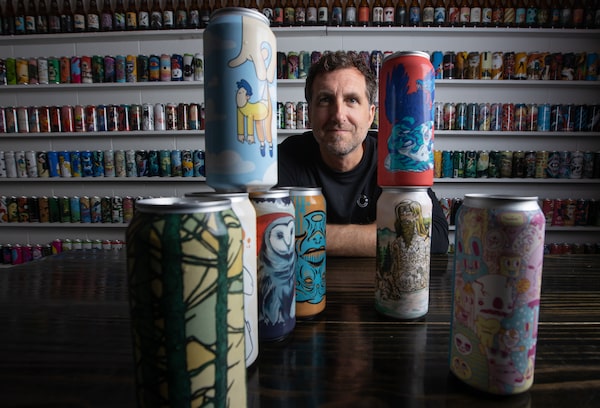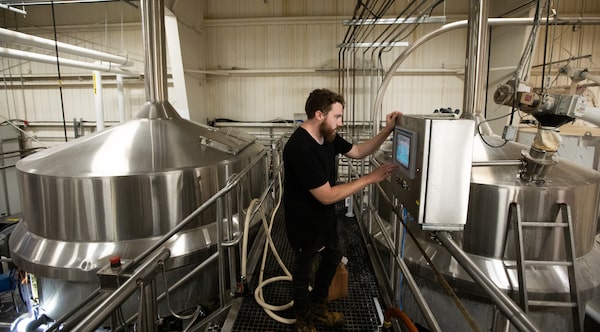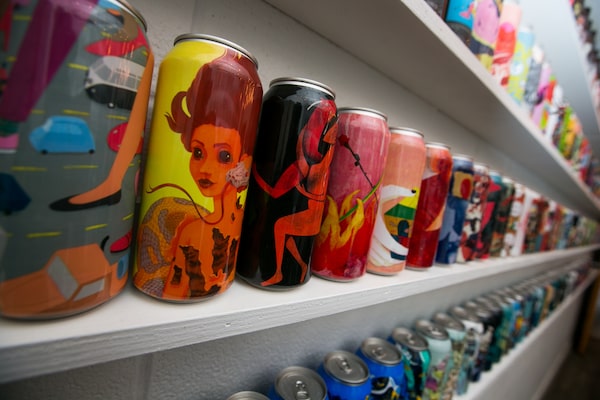
Matt Johnston, co-founder and CEO of Hamilton's Collective Arts Brewing, shows off some of his company's products on Aug. 28, 2020.Glenn Lowson/The Globe and Mail
When Collective Arts Brewing moved into the long-vacant Lakeport Brewery facility in Hamilton’s north end five years ago, it purchased two small canning lines that filled 15 cans per minute, running alongside a line that filled bottles. It was enough for the still-fledgling company at the time, but pales in comparison to the 200 cans per minute the company can pull off today, thanks to a modernized canning line.
The Hamilton-based brewery – known for the diverse original artwork on its cans and beers such as Ransack the Universe IPA and Jam Up the Mash sour – needed a technological update to embark on its rapid expansion to markets around the world. It also needed to better compete in an industry that now favours cans over bottles.
The more modern canning line set up in 2018 doesn’t just produce more beer but also helps it stay fresher for longer, says the company’s chief executive officer Matt Johnston.
“Oxygen is our nemesis,” says Mr. Johnston, who co-founded the company in 2013 with Bob Russell to use his entrepreneurial drive to champion art he was passionate about. “Higher-quality equipment, going faster, results in less oxygen getting into the beer. It’s also a big improvement in accuracy and consistency: not overfilling, not underfilling.”
The canning line, from Italian-based CFT Group, combined with a new keg-filling line installed this spring, cost the company “well under $2-million,” says its communications director Toni Shelton. She says the investment will pay for itself by the end of next year because it can produce more beer.
The new equipment also had the benefit of easing the company’s shift schedule.
“We had to operate those old canning lines 24/7,” Mr. Johnston says. “Now, we are at a more manageable workweek.”

Brewer Zach Heisey at work at Collective Arts on Aug. 28, 2020.Glenn Lowson/The Globe and Mail
The speed of the canning line is a common chokepoint in craft breweries, according to Niagara College professor Jon Downing, a professor in the school’s brewmaster program. The line typically sanitizes the cans, dries them, fills them with beer and attaches the lid.
Better lines move more quickly and fill more cans per minute, sometimes simultaneously, says Downing, who opened Ontario’s first brewpub, The Atlas Hotel, in Welland in 1986.
The “fancy ones” evacuate the air from the cans and pressurize them with carbon dioxide so the can is filled faster, Mr. Downing adds.
“Very tiny amounts of oxygen will spoil beer – 60 or 70 parts per billion,” he explains, adding that a 200-can-per-minute line, such as the one at Collective Arts, is likely faster than lines at most craft breweries in Canada.
Many breweries fill between 40 cans and 80 cans per minute. On the other end of the spectrum are giants such Molson and Labatt, whose lines run somewhere near 500 cans a minute, Mr. Downing says.
“For a small brewery trying to expand, the technology is the difference,” he says.

Scott Rogers and Brett Taylor clean brewery equipment on Aug. 28, 2020.Glenn Lowson/The Globe and Mail
Contrary to expectations, a more automated canning line doesn’t typically reduce the number of employees needed in the brewery, Mr. Downing adds.
To make the most of the new asset, brewers will move workers into areas such as quality control and lab work and increase brewing capacity so that the canning line doesn’t sit idle.
Collective Arts, which has about 150 employees, has kept its canning staff in packaging roles and eliminated the need for night shifts.
In addition to speed and quality improvements, a new canning line can also help breweries reduce their losses, says brewing consultant Kyle Smith, owner of Gorman & Smith Beverage Equipment.
Mr. Smith says older lines tend to be less precise, meaning the cans end up underfilled and unsuitable for sale.
“You have so much beer that you’re starting with, and you want to get as much into the packaged product as possible,” Mr. Smith says. “To correct or prevent short fills, brewers tend to overfill the package to help reduce the chance of … being out of spec. Better to be over than under.”
He says a more consistent packaging line can “easily” save 3 per cent to 4 per cent more beer that would otherwise have been used for overfilling.
“That’s … a big increase to your total product volume,” Mr. Smith says.

Collective Arts is renowned both for its beer and for the artwork that adorns its cans.Glenn Lowson/The Globe and Mail
With the new canning line in place, Collective Arts has removed its bottling line completely.
“The industry has shifted over to cans, and for us, it’s a better representation of the artists,” Mr. Johnston says. Collective Arts does use bottles for its gin, but that is bottled off-site, says Ms. Shelton.
Collective Arts plans to open a small brewpub in Toronto this month and is working on opening a brewery in New York City, where it sees strong sales of its products today.
“We’re still working to expand globally, quickly,” Mr. Johnston says, adding the brand is now in nearly 20 countries, focused on markets with vibrant arts communities such as Seoul, London and Stockholm.
“We want to be seen as the beer of creativity.”
The company’s creative branding, investment in technology and, of course, its beer, has helped its sales grow by an average annual compound growth rate of 60 per cent since 2015 – demand that has been met by the addition of the new canning line.
“At this point, it’s sustainable,” he says of the company’s growth.